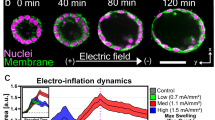Abstract
IN studying the function of the milk gland, with the view of increasing milk production, particular attention has been devoted in recent years to the milk-ejection mechanism (the let-down reflex). Ely and Petersen1 demonstrated the important part played by oxytocin in milk ejection; Grachev2 and Barishnikov et al. 3 emphasized the influence exerted by the central nervous system.
This is a preview of subscription content, access via your institution
Access options
Subscribe to this journal
Receive 51 print issues and online access
$199.00 per year
only $3.90 per issue
Buy this article
- Purchase on Springer Link
- Instant access to full article PDF
Prices may be subject to local taxes which are calculated during checkout
Similar content being viewed by others
References
Ely and Petersen, J. Dairy Sci., 17 (1937).
Grachev, P. I., Zh. Obsh. Biol. (U.S.S.R.), 14, 333 (1953).
Barishnikov, I. A., Borsuk, V. N., Zax, M. G., Zotikova, I. N., Pavlov, G. N., and Tolbukhin, V. I., Zh. Obsh. Biol. (U.S.S.R.), 14, 257 (1953).
Author information
Authors and Affiliations
Rights and permissions
About this article
Cite this article
BILEK, J., JANOVSKY, M. A Radiographic Method for the Study of the Function of the Cow's Udder. Nature 177, 582–583 (1956). https://doi.org/10.1038/177582a0
Issue Date:
DOI: https://doi.org/10.1038/177582a0
Comments
By submitting a comment you agree to abide by our Terms and Community Guidelines. If you find something abusive or that does not comply with our terms or guidelines please flag it as inappropriate.



